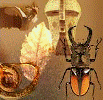Museum, University of Nebraska State
Date of this Version
1976
Abstract
Just about everyone loves dinosaurs! Just ask any museum guard, 4th grader, or grandparent looking for souvenirs at a museum's gift shop. The only natural history exhibits that persistently challenge their popularity, in a child's mind, are the fabled mummies of ancient Egypt. Why does just the mention of the name "dinosaur" activate the imagination of most people? Naturally their size and dominating appearance are significant; however, we would hope people are also ---I intrigued by the very fact that these majestic beasts really existed at all, and for some ill-explained reason ----I seemed to disappear at the height of their reign. How could these impressive animals develop as part of nature's plan? What did they really look like, how did they live, and have they left any descendants among us? These are the types of questions natural history museums should stimulate in visitors, for it is in museums where dinosaurs recapture their three-dimensional form; that imaginations can recreate the Mesozoic world of 150 million years ago. We know that these animals weren't "freaks" in any sense of the word; rather they were a product of nature's changing scene, a biologic potential carried to a natural conclusion through evolutionary processes.



Comments
Published in UNL News: Museum Notes (September 1976) 56(6): 8 p.